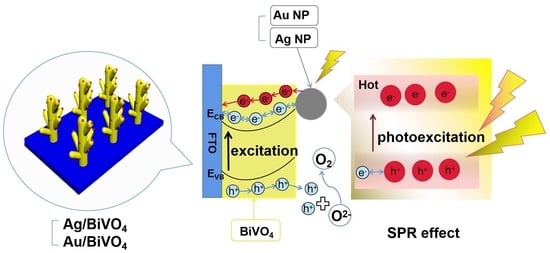Surface Plasmon Resonance Effect of Noble Metal (Ag and Au) Nanoparticles on BiVO4 for Photoelectrochemical Water Splitting
Abstract
:1. Introduction
Characterization
2. Results and Discussion
3. Conclusions
4. Experimental Section
4.1. Synthesis of BiVO4 Films
4.2. Fabrication of Ag/BiVO4 and Au/BiVO4 Photoanodes
Author Contributions
Funding
Data Availability Statement
Conflicts of Interest
References
- Chen, D.; Liu, Z.F.; Guo, Z.G.; Yan, W.G.; Xin, Y. Enhancing light harvesting and charge separation of Cu2O photocathodes with spatially separated noble-metal cocatalysts towards highly efficient water splitting. J. Mater. Chem. A 2018, 6, 20393–20401. [Google Scholar] [CrossRef]
- Wang, Z.; Li, C.; Domen, K. Recent developments in heterogeneous photocatalysts for solar-driven overall water splitting. Chem. Soc. Rev. 2019, 48, 2109–2125. [Google Scholar] [CrossRef] [PubMed]
- Wang, W.H.; Qi, L.M. Light Management with patterned micro- and nanostructure arrays for photocatalysis, photovoltaics, and optoelectronic and optical devices. Adv. Funct. Mater. 2019, 29, 1807275. [Google Scholar] [CrossRef]
- Tilley, S.D. Recent advances and emerging trends in photoelectrochemical solar energy conversion. Adv. Energy Mater. 2019, 9, 1802877. [Google Scholar] [CrossRef]
- Feng, J.N.; Bian, J.; Bai, L.L.; Xi, S.B.; Wang, Y.; Chen, C.L.; Jing, L.Q. Efficient wide-spectrum photocatalytic overall water splitting over ultrathin molecular nickel phthalocyanine/BiVO4 Z-scheme heterojunctions without noble metals. Appl. Catal. B Environ. 2021, 295, 120260. [Google Scholar] [CrossRef]
- Zheng, C.Y.; Yin, M.M.; Ge, R.; Wei, J.; Su, B.Y.; Chen, X.; Chen, X.M. Competitive near-infrared PEC immunosorbent assay for monitoring okadaic acid based on a disposable flower-like WO3-Modified screen-printed electrode. Biosens. Bioelectron. 2021, 185, 113278. [Google Scholar] [CrossRef]
- Dou, Y.B.; Zhou, J.; Zhou, A.; Li, J.R.; Nie, Z.R. Visible-light responsive MOF encapsulation of noble-metal-sensitized semiconductors for high-performance photoelectrochemical water splitting. J. Mater. Chem. 2017, 5, 19491. [Google Scholar] [CrossRef]
- Zhou, T.S.; Chen, S.; Wang, J.C.; Zhang, Y.; Li, J.H.; Bai, J.; Zhou, B.X. Dramatically enhanced solar-driven water splitting of BiVO4 photoanode via strengthening hole transfer and light harvesting by co-modification of CQDs and ultrathin beta-FeOOH layers. Chem. Eng. J. 2021, 403, 126350. [Google Scholar] [CrossRef]
- Hernández-Alonso, M.D.; Fresno, F.; Suárez, S.; Coronado, J.M. Development of alternative photocatalysts to TiO2: Challenges and opportunities. Energy Environ. Sci. 2009, 2, 1231–1257. [Google Scholar] [CrossRef]
- Son, M.K.; Pan, L.F.; Mayer, M.T.; Hagfeldt, A.; Gratzel, M.; Luo, J.S. Structural and compositional investigations on the stability of cuprous oxide nanowire photocathodes for photoelectrochemical water splitting. ACS Appl. Mater. Interfaces 2021, 13, 55080–55091. [Google Scholar] [CrossRef]
- Luo, W.J.; Yang, Z.S.; Li, Z.S.; Zhang, J.Y.; Liu, J.G.; Zhao, Z.Y.; Wang, Z.Q.; Yan, S.C.; Yu, T.; Zou, Z.G. Solar hydrogen generation from seawater with a modified BiVO4 photoanode. Energy Environ. Sci. 2011, 4, 4046–4051. [Google Scholar] [CrossRef]
- Wu, J.M.; Chen, Y.; Pan, L.; Wang, P.H.; Cui, Y.; Kong, D.C.; Wang, L.; Zhang, X.W.; Zou, J.J. Multi-layer monoclinic BiVO4 with oxygen vacancies and V4+ species for highly efficient visible-light photoelectrochemical applications. Appl. Catal. B Environ. 2018, 221, 187–195. [Google Scholar] [CrossRef]
- Ye, K.Y.; Chai, Z.S.; Gu, J.W.; Yu, X.; Zhao, C.X.; Zhang, Y.M.; Mai, W.J. BiOI-BiVO4 photoanodes with significantly improved solar water splitting capability: P-n junction to expand solar adsorption range and facilitate charge carrier dynamics. Nano Energy 2015, 18, 222–231. [Google Scholar] [CrossRef]
- Li, J.Q.; Guo, Z.Y.; Liu, H.; Du, J.; Zhu, A.F. Two-step hydrothermal process for synthesis of F-doped BiVO4 spheres with enhanced photocatalytic activity. J. Alloys Compd. 2013, 581, 40–45. [Google Scholar] [CrossRef]
- Wang, S.G.; Chen, P.; Bai, Y.; Yun, J.H.; Liu, G.; Wang, L.Z. New BiVO4 dual photoanodes with enriched oxygen vacancies for efficient solar-driven water splitting. Adv. Mater. 2018, 30, 1800486. [Google Scholar] [CrossRef]
- Thalluri, S.M.; Hernández, S.; Bensaid, S.; Saracco, G.; Russo, N. Green-synthesized W and Mo-doped BiVO4 oriented along the 040 facet with enhanced activity for the sun-driven water oxidation. Appl. Catal. B Environ. 2016, 180, 630–636. [Google Scholar] [CrossRef]
- Liu, R.; Wang, D.; Han, C.C.; Wang, P.; Tong, Z.F.; Tan, B.H.; Liu, Z.F. The synergistic effect of CuBi2O4 and Co-Pi: Improving the PEC activity of BiVO4-based composite materials. New J. Chem. 2022, 46, 2971–2979. [Google Scholar] [CrossRef]
- Fang, G.Z.; Liu, Z.F.; Han, C.C. Enhancing the PEC water splitting performance of BiVO4 co-modifying with NiFeOOH and Co-Pi double layer cocatalysts. Appl. Surf. Sci. 2020, 515, 146095. [Google Scholar] [CrossRef]
- Geng, H.M.; Ying, P.Z.; Zhao, Y.L.; Gu, X.Q. Cactus shaped FeOOH/Au/BiVO4 photoanodes for efficient photoelectrochemical water splitting. Int. J. Hydrogen Energy 2021, 46, 35280–35289. [Google Scholar] [CrossRef]
- Su, F.L.; Wang, T.; Lv, R.; Zhang, J.J.; Zhang, P.; Lu, J.W.; Gong, J.L. Dendritic Au/TiO2 nanorod arrays for visible-light driven photoelectrochemical water splitting. Nanoscales 2013, 5, 9001–9009. [Google Scholar] [CrossRef]
- Nga, T.T.T.; Huang, Y.C.; Chen, J.L.; Chen, C.L.; Lin, B.H.; Yeh, P.H.; Du, C.H.; Chiou, J.W.; Pong, W.F.; Arul, K.T.; et al. Effect of Ag-decorated BiVO4 on photoelectrochemical water splitting: An X-ray absorption spectroscopic investigation. Nanomaterials 2022, 12, 3659. [Google Scholar] [CrossRef] [PubMed]
- Li, M.; Tu, X.L.; Su, Y.J.; Lu, J.; Hu, J.; Cai, B.F.; Zhou, Z.H.; Yang, Z.; Zhang, Y.F. Controlled growth of vertically aligned ultrathin In2S3 nanosheet arrays for photoelectrochemical water splitting. Nanoscale 2018, 10, 1153–1161. [Google Scholar] [CrossRef] [PubMed]
- Kim, J.H.; Jo, Y.H.; Kim, J.H.; Lee, J.S. Ultrafast fabrication of highly active BiVO4 photoanodes by hybrid microwave annealing for unbiased solar water splitting. Nanoscale 2016, 8, 17623–17631. [Google Scholar] [CrossRef] [PubMed]
- Myung, N.; Ham, S.; Choi, S.; Chae, Y.; Rajeshwar, K. Tailoring interfaces for electrochemical synthesis of semiconductor films: BiVO4, Bi2O3, or composites. J. Phys. Chem. C 2011, 115, 7793–7800. [Google Scholar] [CrossRef]
- Gu, X.N.; Zhang, J.L.; Hou, L.Q.; Fu, X.H.; Yu, X.; Zhu, Y.; Zhang, Y.M. Dual modification with Ag and FeOOH significantly increased the photoelectrochemical water splitting activity of BiVO4 photoanodes. Surf. Interfaces 2021, 25, 101224. [Google Scholar] [CrossRef]
- Gao, X.T.; Bai, Z.Q.; Zhang, S.; Liu, J.C.; Li, Z.H. Highly efficient hamburger-like nanostructure of a triadic Ag/Co3O4/BiVO4 photoanode for enhanced photoelectrochemical water oxidation. RSC Adv. 2020, 10, 45067. [Google Scholar] [CrossRef]
- Zhang, L.; Herrmann, L.O.; Baumberg, J.J. Size dependent plasmonic effect on BiVO4 photoanodes for solar water splitting. Sci. Rep. 2015, 5, 16660. [Google Scholar] [CrossRef]
- Lim, F.S.; Tan, S.T.; Zhu, Y.M.; Chen, J.W.; Wu, B.; Yu, H.; Kim, J.M.; Ginting, R.T.; Lau, K.S.; Chia, C.H.; et al. Tunable plasmon-induced charge transport and photon absorption of bimetallic Au-Ag nanoparticles on ZnO photoanode for photoelectrochemical enhancement under visible light. J. Phys. Chem. 2020, 124, 14105–14117. [Google Scholar] [CrossRef]
- Linic, S.; Christopher, P.; Ingram, D.B. Plasmonic-metal nanostructures for efficient conversion of solar to chemical energy. Nat. Mater. 2011, 10, 911–921. [Google Scholar] [CrossRef]
- Walter, M.G.; Warren, E.L.; Mckone, J.R.; Boettcher, S.W.; Lewis, N.S. Solar water splitting cells. Chem. Rev. 2010, 110, 6446–6473. [Google Scholar] [CrossRef]
- Tian, Y.; Cui, Q.Q.; Xu, L.L.; Jiao, A.X.; Ma, H.; Wang, C.; Zhang, M.Y.; Wang, X.L.; Li, S.; Chen, M. Alloyed AuPt nanoframes loaded on h-BN nanosheets as an ingenious ultrasensitive near-infrared photoelectrochemical biosensor for accurate monitoring glucose in human tears. Biosens. Bioelectron. 2021, 192, 113490. [Google Scholar] [CrossRef] [PubMed]
- Long, X.F.; Gao, L.L.; Li, F.; Hu, Y.P.; Wei, S.Q.; Wang, C.L.; Wang, T.; Jin, J.; Ma, J.T. Bamboo shoots shaped FeVO4 passivated ZnO nanorods photoanode for improved charge separation/transfer process towards efficient solar water splitting. Appl. Catal. B Environ. 2019, 257, 117813. [Google Scholar] [CrossRef]
- Nan, F.; Kang, Z.; Wang, J.; Shen, M.; Fang, L. Carbon quantum dots coated BiVO4 inverse opals for enhanced photoelectrochemical hydrogen generation. Appl. Phys. Lett. 2015, 106, 153901–153905. [Google Scholar] [CrossRef]
- Jiao, Z.; Zhang, Y.; Ouyang, S.; Yu, H.; Lu, G.; Ye, J.; Bi, Y. BiAg alloy nanospheres: A new photocatalyst for H2 evolution from water splitting. ACS Appl. Mater. Interfaces 2014, 6, 19488–19493. [Google Scholar] [CrossRef]
- Kim, T.W.; Choi, K.S. Nanoporous BiVO4 photoanodes with dual-layer oxygen evolution catalysts for solar water splitting. Science 2014, 343, 990–994. [Google Scholar] [CrossRef]


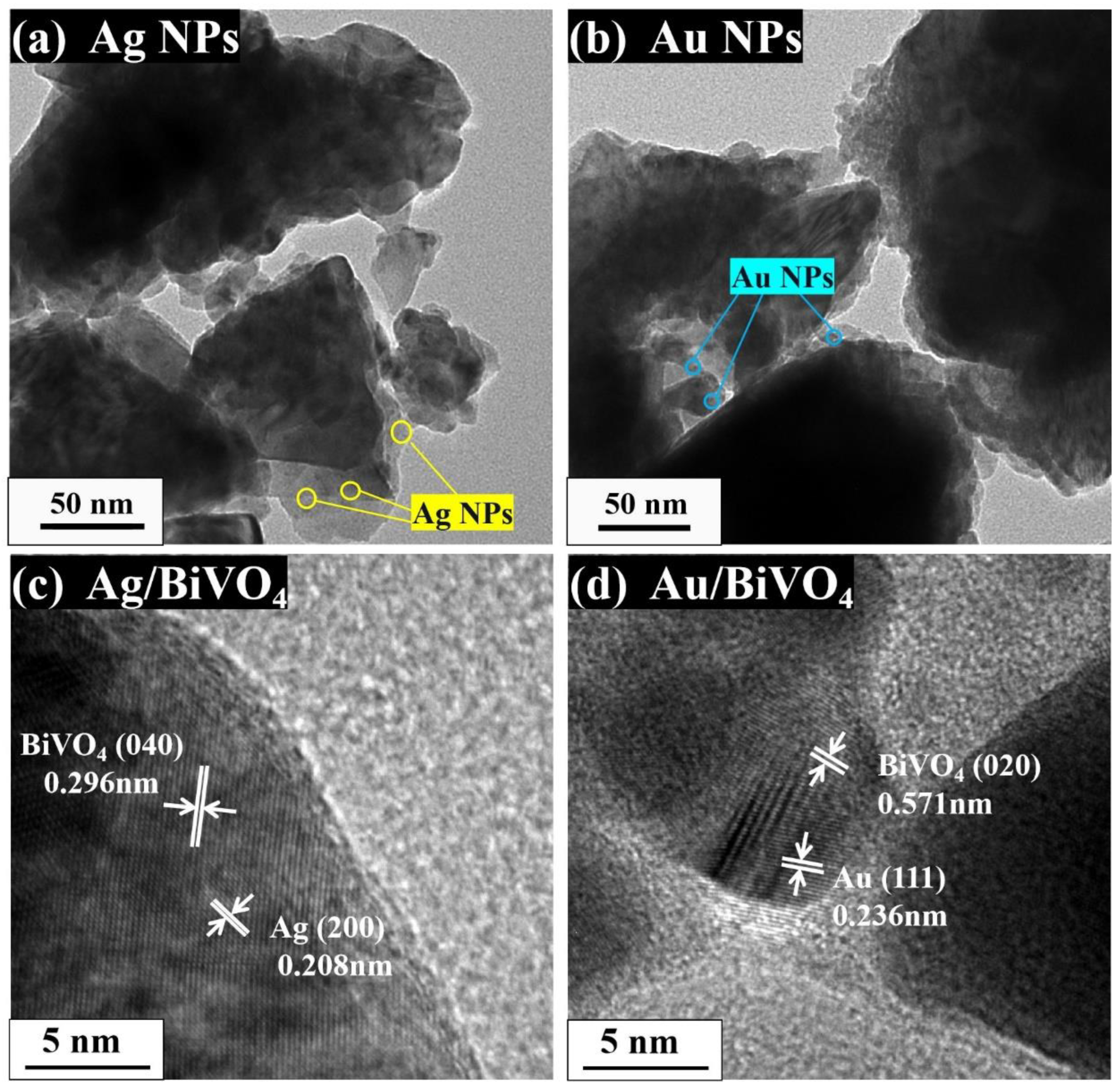
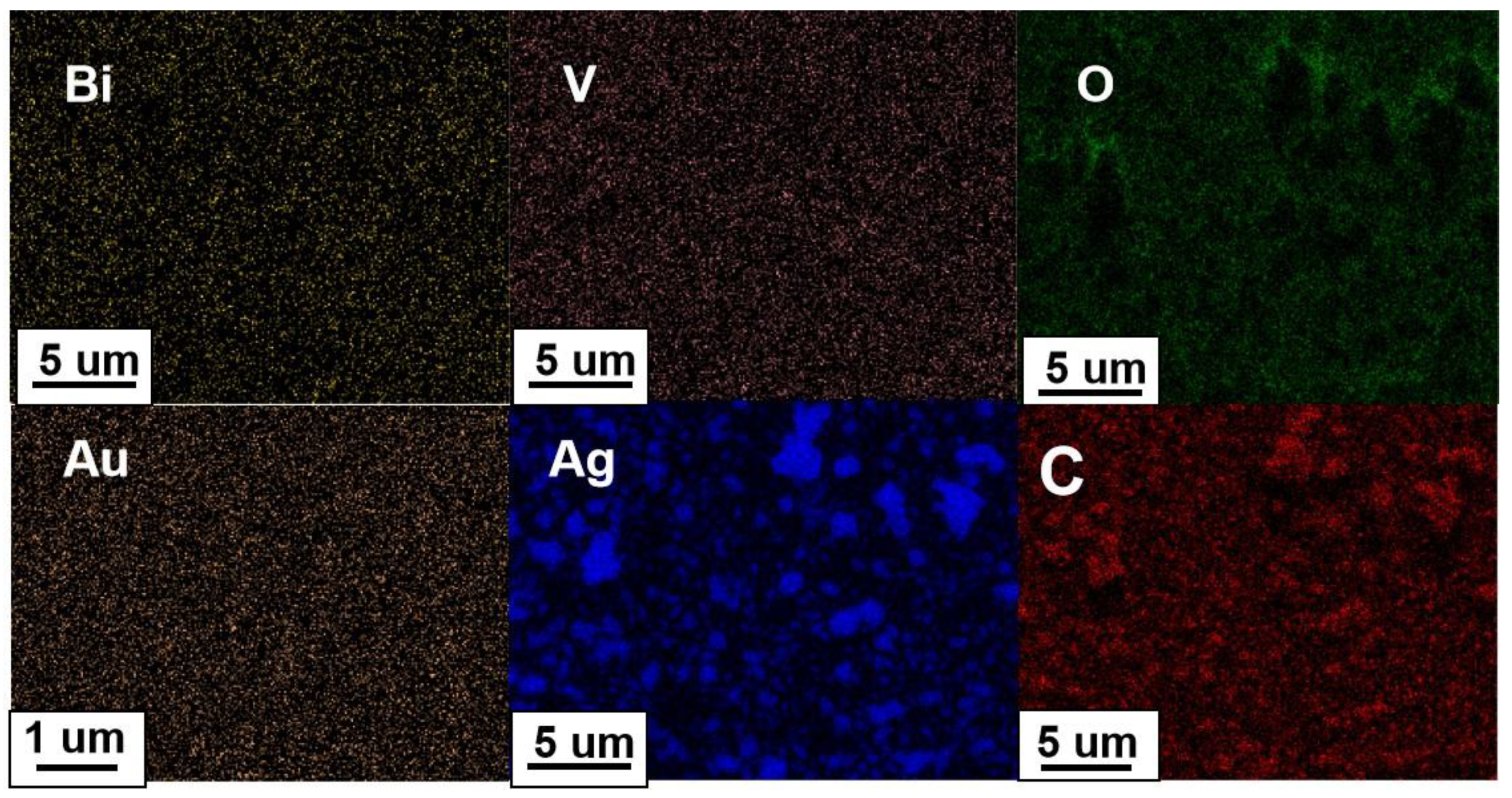
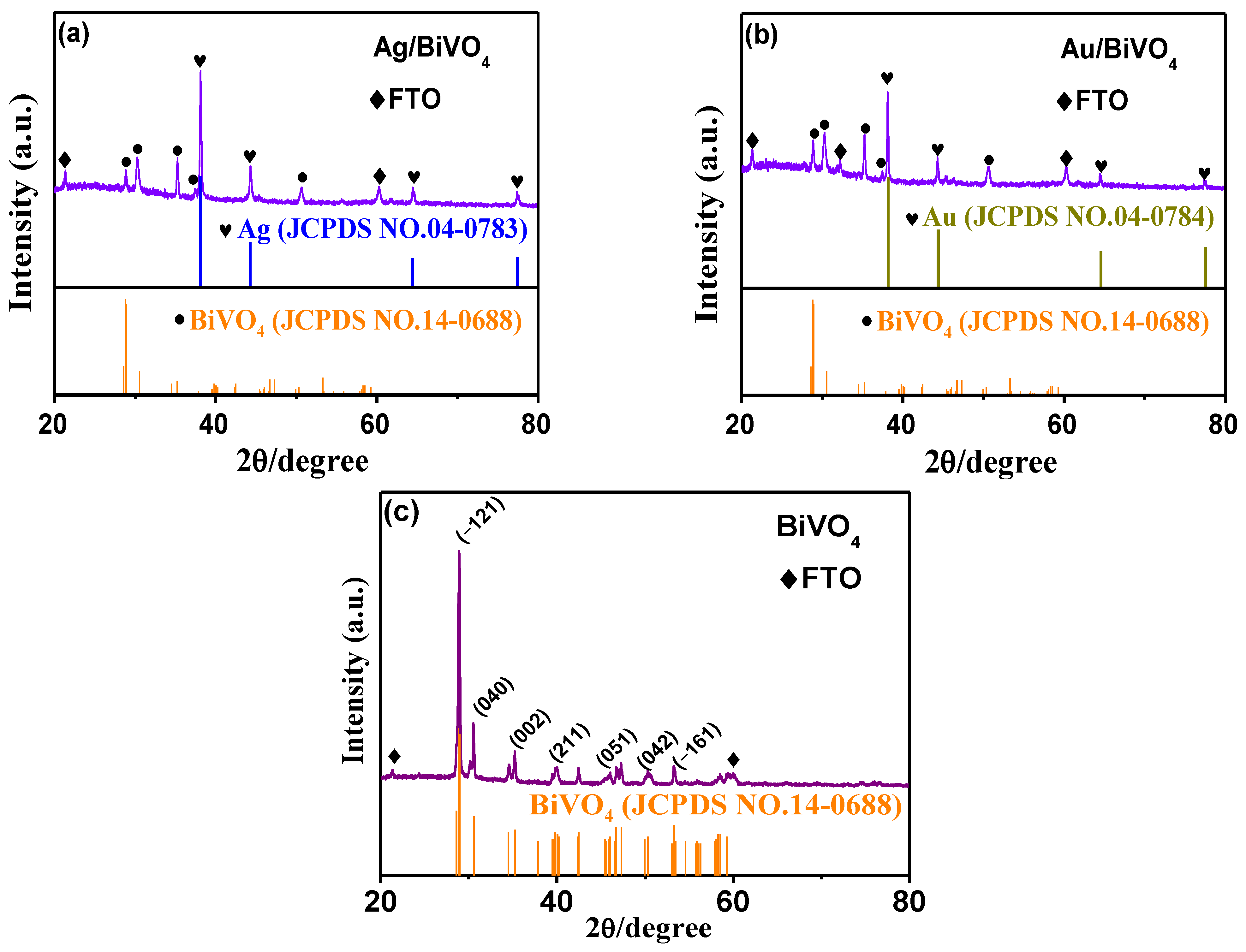

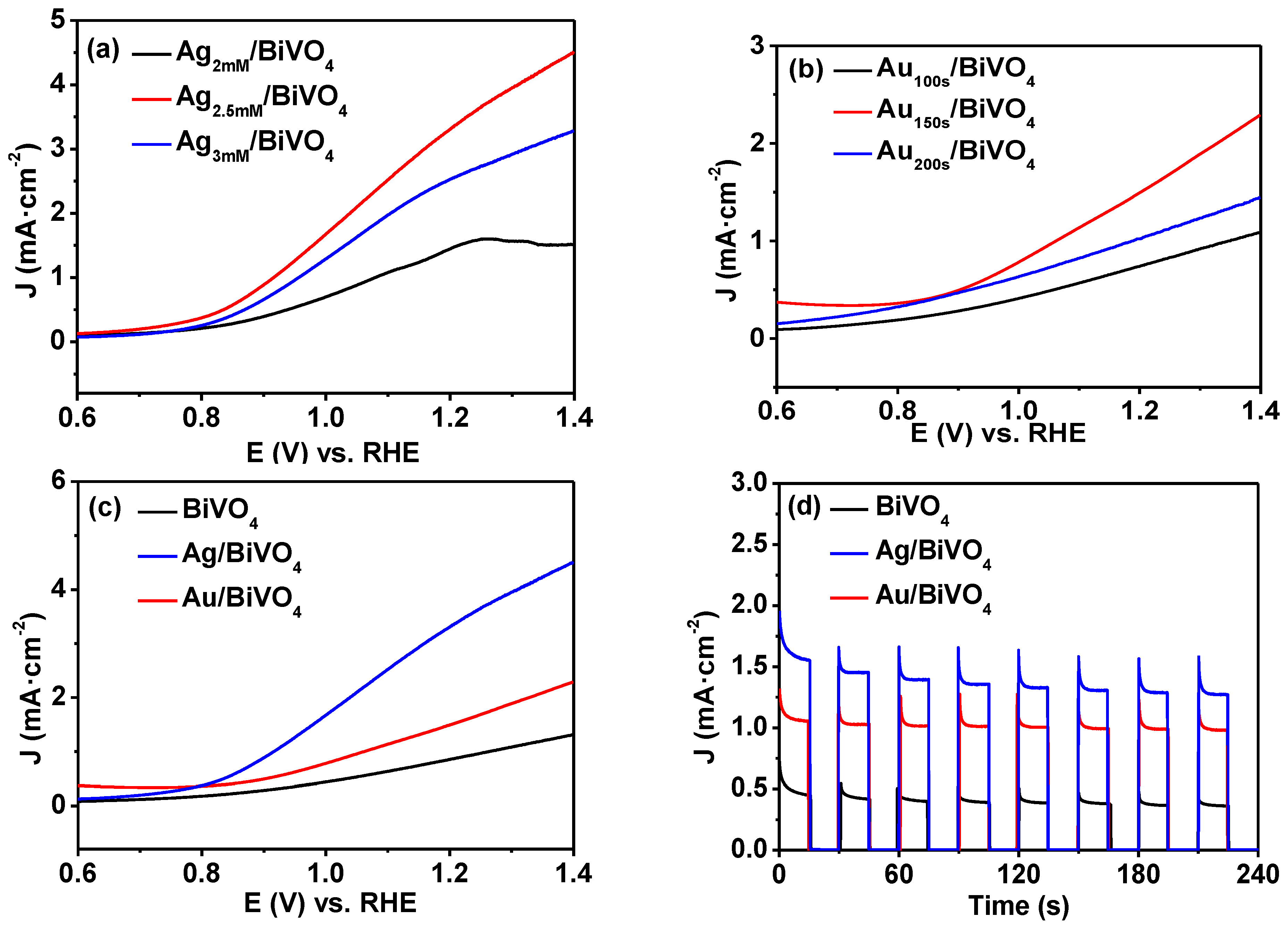


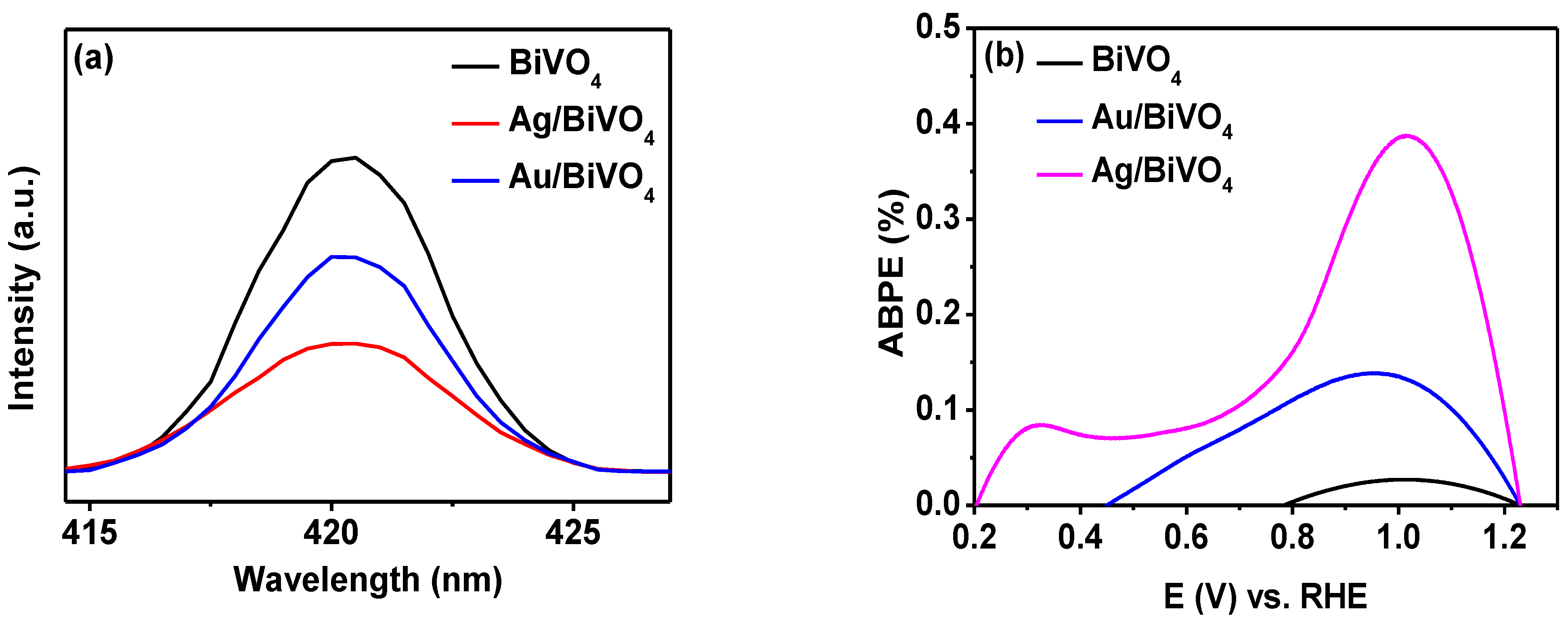
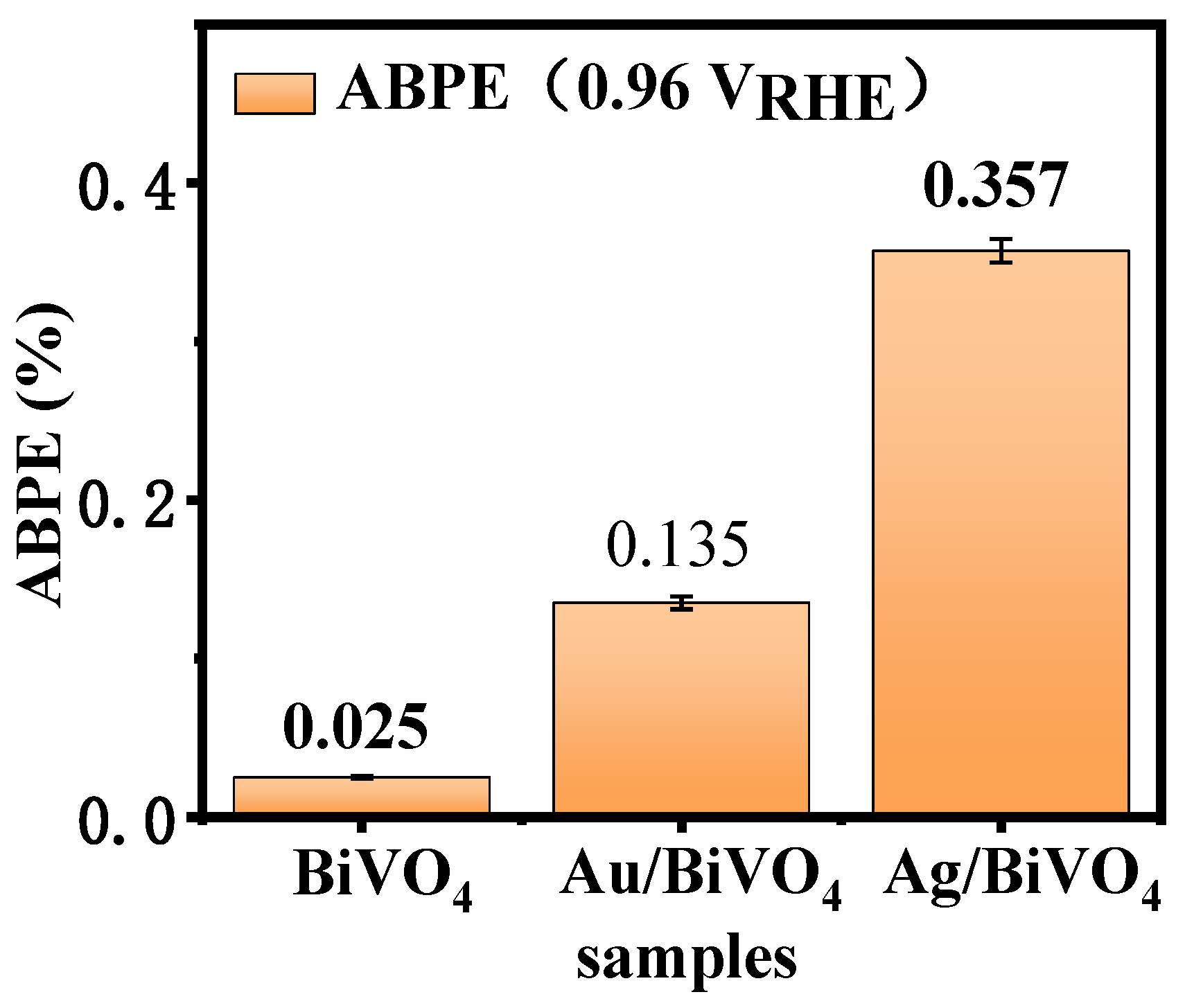


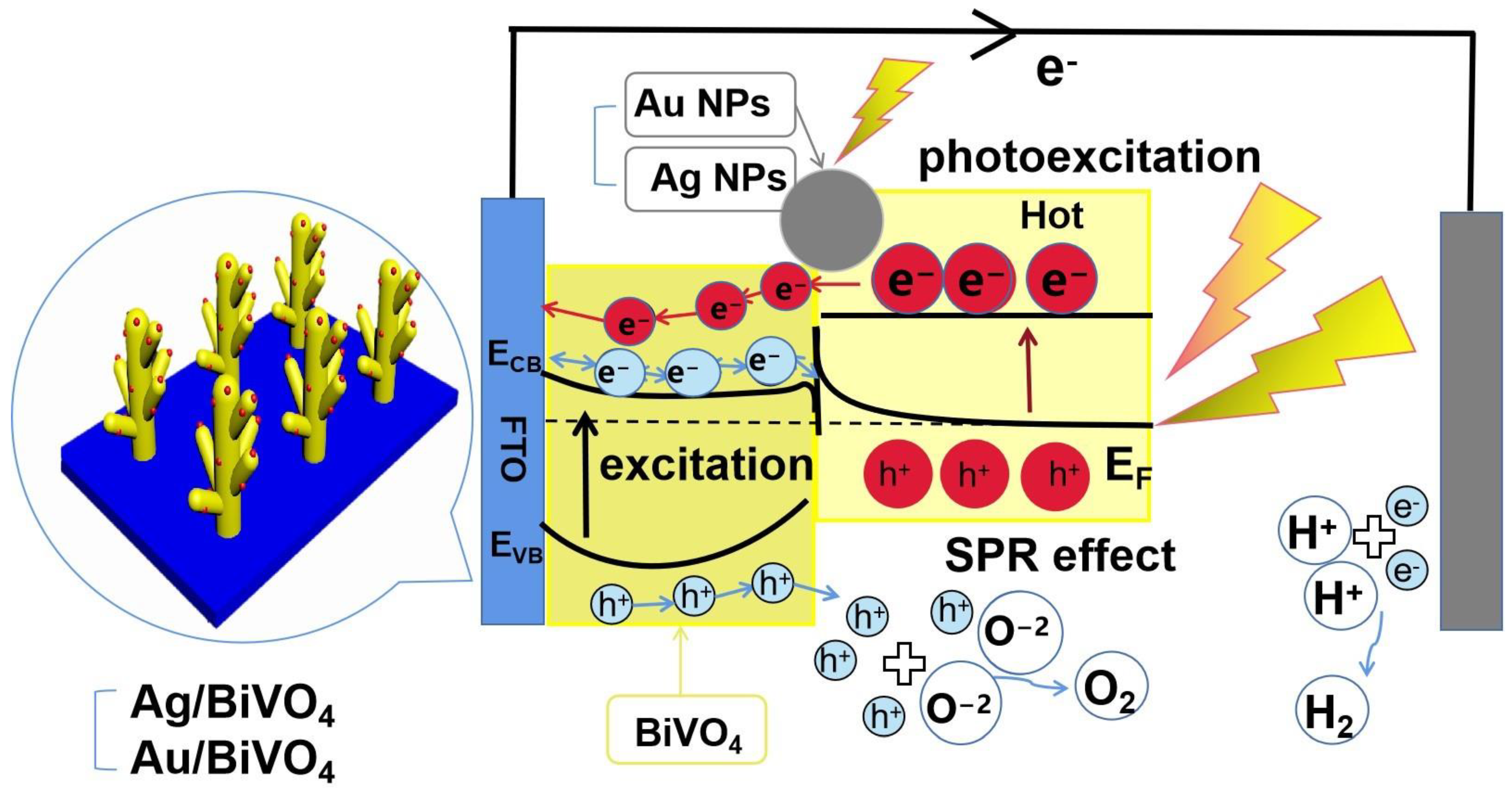
Disclaimer/Publisher’s Note: The statements, opinions and data contained in all publications are solely those of the individual author(s) and contributor(s) and not of MDPI and/or the editor(s). MDPI and/or the editor(s) disclaim responsibility for any injury to people or property resulting from any ideas, methods, instructions or products referred to in the content. |
© 2023 by the authors. Licensee MDPI, Basel, Switzerland. This article is an open access article distributed under the terms and conditions of the Creative Commons Attribution (CC BY) license (https://creativecommons.org/licenses/by/4.0/).
Share and Cite
Liu, R.; Zhan, D.; Wang, D.; Han, C.; Fu, Q.; Zhu, H.; Mao, Z.; Liu, Z.-Q. Surface Plasmon Resonance Effect of Noble Metal (Ag and Au) Nanoparticles on BiVO4 for Photoelectrochemical Water Splitting. Inorganics 2023, 11, 206. https://doi.org/10.3390/inorganics11050206
Liu R, Zhan D, Wang D, Han C, Fu Q, Zhu H, Mao Z, Liu Z-Q. Surface Plasmon Resonance Effect of Noble Metal (Ag and Au) Nanoparticles on BiVO4 for Photoelectrochemical Water Splitting. Inorganics. 2023; 11(5):206. https://doi.org/10.3390/inorganics11050206
Chicago/Turabian StyleLiu, Rui, Difu Zhan, Dong Wang, Changcun Han, Qian Fu, Hongxun Zhu, Zhuxiang Mao, and Zhao-Qing Liu. 2023. "Surface Plasmon Resonance Effect of Noble Metal (Ag and Au) Nanoparticles on BiVO4 for Photoelectrochemical Water Splitting" Inorganics 11, no. 5: 206. https://doi.org/10.3390/inorganics11050206
APA StyleLiu, R., Zhan, D., Wang, D., Han, C., Fu, Q., Zhu, H., Mao, Z., & Liu, Z.-Q. (2023). Surface Plasmon Resonance Effect of Noble Metal (Ag and Au) Nanoparticles on BiVO4 for Photoelectrochemical Water Splitting. Inorganics, 11(5), 206. https://doi.org/10.3390/inorganics11050206






